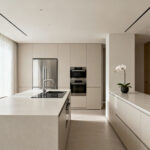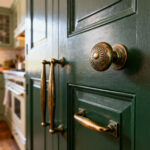Picture this: It’s 1880, and you’re standing in a Victorian-era bedroom in Milwaukee. The gas lamps cast a warm, flickering glow on the deep burgundy walls, creating an atmosphere of cozy opulence. Now, fast forward to today, where LED bulbs illuminate the same room, transforming that once-rich burgundy into a vibrant, almost electric shade. Fascinating, isn’t it? This little time-travel experiment illustrates a crucial point in interior design: lighting and bedroom paint colors are intrinsically linked, each profoundly influencing how we perceive the other.
As an urban planner with a passion for historic preservation, I’ve seen firsthand how the interplay between light and color can breathe new life into spaces, both old and new. Whether you’re renovating a charming 19th-century brownstone or designing a sleek, modern loft, understanding this relationship is key to creating a bedroom that’s not just aesthetically pleasing, but also emotionally resonant.
In this article, we’ll explore the nuanced dance between lighting and bedroom paint colors, offering insights and tips to help you transform your sleeping space into a personalized retreat. And if you’re feeling stuck, don’t worry! We’ve got plenty of cool bedroom paint ideas to spark your creativity. So, grab a cup of tea, and let’s embark on this illuminating journey together!

Key Takeaways
Before we dive into the nitty-gritty, let’s highlight some crucial points to keep in mind:
- Lighting is the unsung hero of interior design, capable of dramatically altering how paint colors appear in your bedroom.
- Always test paint colors under various lighting conditions – what looks perfect in the store might surprise you at home!
- Your bedroom’s paint color should reflect the mood you want to create. Are you aiming for calm serenity or energizing vibrancy?
- Don’t underestimate the power of paint samples. They’re your best friends in the color selection process.
- Remember, lighter hues can make a room feel more spacious, while darker tones create intimacy.
- Consider your bedroom’s size and orientation when choosing colors. A small, north-facing room might benefit from brighter shades to feel more inviting.
The Impact of Lighting on Paint Colors
Let me tell you a quick story. When I was renovating my 1920s bungalow in Milwaukee, I painted my bedroom a soft, buttery yellow. In the morning, it was like waking up inside a sunny daisy – delightful! But as the day progressed, I noticed how the color shifted. By late afternoon, it had transformed into a warm, golden hue that made me feel like I was basking in the glow of a perpetual sunset.

This experience taught me a valuable lesson about natural light and its influence on bedroom paint colors. South and west-facing windows invite intense sunlight, which can intensify colors, especially darker ones. On the flip side, north-facing rooms receive cooler, more consistent light throughout the day, which can make colors appear more muted.
When selecting lighting and bedroom paint colors, consider how natural light interacts with your space throughout the day. It’s like choreographing a dance between the sun and your walls!
Artificial Light: The Great Color Chameleon
Now, let’s flip the switch and talk about artificial lighting. In my years of working on urban revitalization projects, I’ve seen how different types of bulbs can completely transform a space. It’s like having a magic wand that can alter the mood of a room instantly!
LED bulbs, for instance, emit a bright, white light that can make colors appear crisper and more vibrant. Incandescent bulbs, on the other hand, cast a warm, yellowish glow that can soften and warm up colors. It’s crucial to consider these effects when choosing lighting and bedroom paint colors.

Here’s a fun experiment: take a paint swatch and look at it under different light bulbs. You’ll be amazed at how the color seems to shape-shift before your eyes!
Light Position and Color: The Art of Illumination
The placement of your light sources can create intriguing shadow play and affect color distribution in your bedroom. I once worked on a project where we installed uplighting in a bedroom with deep blue walls. The effect was stunning – it created an atmosphere reminiscent of a starry night sky!
Don’t be afraid to experiment with colored bulbs, either. A soft blue light can transform a neutral-colored room into a tranquil oasis, perfect for winding down after a long day.
Warm vs. Cool Lighting: Setting the Tone
When it comes to lighting and bedroom paint colors, the temperature of your light sources plays a crucial role. Warm lighting, with its golden hues, can make a space feel cozy and intimate. It’s particularly flattering for darker, richer paint colors.

Cool lighting, on the other hand, can make a room feel more spacious and modern. It works wonders with lighter, crisper paint shades. The key is to find the right balance for your space and preferences.
Testing Paint Colors Under Different Lighting
When I’m helping clients choose matching paint colors for bedroom style, I always insist on testing samples in natural light. Paint a large swatch on your wall and observe it throughout the day. You might be surprised at how a color that looked perfect at noon can transform into something entirely different by sunset!
Don’t Forget Artificial Lighting
Once the sun goes down, it’s time to see how your chosen colors perform under artificial light. Turn on all your usual light sources and observe how the paint looks. Does it still evoke the feeling you’re after? If not, it might be time to reconsider your choice or adjust your lighting setup.

Time of Day Matters
Remember my yellow bedroom story? That’s a perfect example of how the time of day affects paint colors. A color that looks energizing in the morning might feel too intense in the evening when you’re trying to wind down. Consider how you use your bedroom at different times and choose a color that works well throughout the day.
Sample Boards: Your Color Testing Toolkit
Here’s a pro tip I love to share: create movable sample boards. Paint a piece of poster board with your chosen color and move it around the room. This way, you can see how the color looks in different areas and lighting conditions without committing to painting your walls.
Tips for Choosing Bedroom Paint Colors
When selecting lighting and bedroom paint colors, think of them as dance partners. They should complement each other, not compete. If you have warm, cozy lighting, consider paint colors that enhance that warmth. For rooms with cooler, brighter light, you might opt for colors that balance that intensity.

Consider the Mood You Want to Create
Your bedroom is your sanctuary. The colors you choose should reflect the atmosphere you want to create. Are you looking for a calm, serene space? Soft blues or greens might be your go-to. Want a more energizing environment? Perhaps a vibrant coral or sunny yellow is more your style.
Experiment with Multiple Shades
Don’t be afraid to play around with different shades of the same color. In a recent project, we tested five different shades of gray before finding the perfect one that looked great in both natural and artificial light. It’s all about finding that sweet spot!
Seek Professional Advice
While I’m all for DIY spirit, sometimes a professional eye can be invaluable. An experienced designer can offer insights on trending paint choices and effective color schemes that you might not have considered. They can also help you navigate the sometimes overwhelming world of lighting and bedroom paint colors.

Consider Paint Finishes
Last but not least, don’t forget about bedroom paint finishes. The sheen of your paint can significantly affect how light interacts with the color. A glossy finish will reflect more light, potentially making a color appear brighter, while a matte finish absorbs light, creating a softer, more muted look.
Final Thoughts: Illuminating Your Perfect Space
As we wrap up our journey through the fascinating world of lighting and bedroom paint colors, I’m reminded of a quote by the famous architect Le Corbusier: “Light creates ambiance and feel of a place, as well as the expression of a structure.” In our bedrooms, this couldn’t be more true.
Understanding the intricate dance between light and color empowers you to create a space that’s not just visually appealing, but emotionally resonant. Whether you’re restoring a historic home or designing a contemporary retreat, the principles we’ve explored today will guide you toward creating a bedroom that truly feels like home.

Remember, there’s no one-size-fits-all solution when it comes to lighting and bedroom paint colors. What works in my Milwaukee bungalow might not be the perfect fit for your urban loft or suburban ranch house. The key is to experiment, observe, and trust your instincts.
So, are you ready to transform your bedroom? Grab those paint swatches, play with your light switches, and start your color adventure. Your perfect, mood-enhancing bedroom is just a brushstroke (and a light bulb) away!






